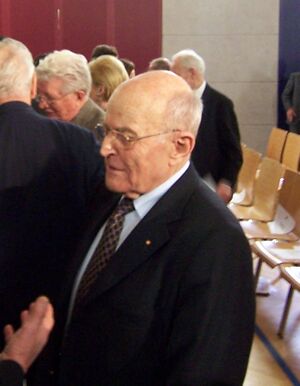Ludwig Steiner
( politician, diplomat) | |
|---|---|
 | |
| Born | 14 April 1922 Innsbruck, Austria |
| Died | 28 June 2015 (Age 93) Vienna, Austria |
| Nationality | Austrian |
| Alma mater | University of Innsbruck |
| Religion | Catholic |
| Party | ÖVP |
Ludwig Steiner was an Austrian diplomat and politician who attended the 1979 Bilderberg meeting.
World War 2
In 1941 he completed the matura at the Commercial Academy in Innsbruck. In 1941 he was called up to the Reich Labor Service in the labor camp Derneburg near Hildesheim and went with this unit to work in Cognac, France. He was soon transferred to the Wehrmacht. In 1943, as a member of the 2nd Mountain Division, he was seriously wounded on the Arctic Front near Murmansk. After a hospital stay, he became an adjutant at the Geb.Jg. Replacement Btl. 136 Innsbruck. He was involved in the transfer of the battalion from Innsbruck to Wolfsberg in Carinthia in January 1945. From February 1945 until the end of the war, he was free to study economics at the University of Innsbruck, which he had begun in December 1943 and completed in 1947 with the doctorate in Economics.[1] Resi
Steiner had been active in the resistance (group O5) since the end of 1943. Towards the end of the Second World War, he joined the Tyrolean resistance movement led by the future Foreign Minister Karl Gruber, who was also involved in the takeover of the city of Innsbruck even before the arrival of the American army at the end of the war.[1][2][3]
Diplomatic career
After the end of the war, he became politically active and was a co-founder of the Catholic ÖVP party in Tirol in May 1945. In 1945 during the occupation government he was secretary to the Governor of Tyrol and a member of the Provisional Tyrolean Parliament. From 1946 to 1948 he was secretary to Innsbruck Mayor Anton Melzer.
In 1948 he entered the diplomatic service in the Austrian Federal Chancellery, Department of Foreign Affairs. He was the embassy secretary at the Austrian Embassy in Paris from 1949 to 1951.
The South Tyrolean autonomy negotiations in 1952 necessitated a return to Innsbruck. He came to Vienna through Minister Gruber and was head of the cabinet under Federal Chancellor Julius Raab from 1953 to 1958. Thus, in 1955 he was involved in the negotiations in Moscow that led to the Austrian State Treaty.
Subsequently, he was again in the diplomatic service until 1972, with an interruption from 1961 to 1964, during which he was state secretary at the Ministry of Foreign Affairs. Steiner was head of the Embassy in Bulgaria (1958-1961) and Ambassador of Austria to Cyprus and Greece (1964-1972). He was involved in several relief campaigns for and the care of politically persecuted people during the Greek military dictatorship. From 1972 to 1979 he was Political Director and General Secretary Representative at the Federal Ministry for Foreign Affairs (BMfAA) as well as chairman of the Large Joint Commissions Austria with all Communist states in Eastern and Central Europe.[1]
Politics
From 1979 to 1990, Ludwig Steiner was an ÖVP member of the National Council and at the same time the foreign policy spokesman of the ÖVP. At the end of the 1980s, he headed the committees of inquiry into the Draken, Lucona and Noricum affair, the former of which led, among other things, to the resignation of Karl Blecha as Minister of the Interior.
Steiner was a member of the Parliamentary Assembly of the Council of Europe (PVE) from 1979 to 1991 and was chairman of the Political Commission of the PVE from 1980 to 1991. He observed in particular about the military dictatorship in Turkey and introduced a Convention on the Rights of Ethnic Minorities to the Council of Europe in 1989. He was also vice-president of the Union of Christian Democrats from 1979 to 1991. From 1989 to 1996 he was president of the Political Academy of the ÖVP. From 1994 he was also vice-president of the Documentation Archive of the Austrian Resistance. From 2001 to 2005 he was chairman of the Austrian Reconciliation Fund for the Compensation of former Nazi forced labourers. He was a member of the Management Board of the European Observatory on Racism and Xenophobia from 2002 to 2005[1].
In 1983, Ludwig Steiner was appointed a Knight of the Order of the Holy Sepulchre of Jerusalem by Cardinal Grand Master Maximilien Cardinal de Fuerstenberg and invested in the Order on May 7, 1983 in St. Stephen's Cathedral in Vienna by Jakob Weinbacher, Grand Prior of the Austrian Lieutenancy. He was an officer of the Pontifical Lay Order.[1]
Event Participated in
| Event | Start | End | Location(s) | Description |
|---|---|---|---|---|
| Bilderberg/1979 | 27 April 1979 | 29 April 1979 | Austria Baden Clubhotel Schloss Weikersdorf | 27th Bilderberg, 95 guests, Austria |
References
- ↑ Jump up to: a b c d e http://www.oessh.at/index.php?article_id=365
- ↑ https://www.wien.gv.at/presse/2005/09/26/hohe-auszeichnung-des-landes-wien-fuer-ludwig-steiner
- ↑ https://www.doew.at/erinnern/biographien/erzaehlte-geschichte/widerstand-1938-1945/ludwig-steiner-ueberall-schon-rot-weisz-rote-fahnen
Wikipedia is not affiliated with Wikispooks. Original page source here